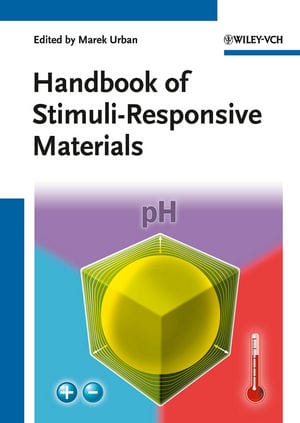 Handbook of Stimuli-Responsive Materials
Handbook of Stimuli-Responsive Materials
Editor: Marek W. Urban
Hardcover
296 pages
US $210.00
The Handbook of Stimuli-Responsive Materials edited by Marek Urban is a comprehensive review of recent advances in stimuli-responsive materials based on functional polymers and colloids. The group of co-authors reflects the multidisciplinary character of this field of functional materials that covers a number of topics from synthesis and self-assembly to modeling and applications.
Multifunctional stimuli-responsive materials rely very much on precisely engineered and well-defined polymeric architectures that can be synthesized and assembled using recently developed advanced methods. In accord with the book concept, the first chapter provides a thorough review of the synthesis of stimuli-responsive polymers using controlled radical polymerization methods: ATRP, NMRP, and RAFT polymerization. These methods provide a precise control of molecular characteristics of polymers and copolymers used as building blocks for stimuli-responsive materials including bulk materials, thin films and colloidal dispersions. The chapter demonstrates how the developed methodology is used for the “exact placement” of functional groups in the polymer backbone and side fragments to synthesize polymers with well-defined molecular architectures and preprogrammed properties.
The methods to design materials that are responsive to biological systems and physical stimuli, including electrical, magnetic fields, ultrasound and light, find logical placement in the following chapter. This chapter bridges the synthesis of well-defined molecular architectures, mechanisms of responsiveness to various stimuli, and applications. The following chapter will surprise readers with a fascinating example of complex behavior of stimuli-responsive materials when chemical energy of the Belousov-Zhabotinsky reactions is transformed to mechanical energy of oscillating polymeric networks. Among important applications of stimuli responsive materials are self-repairing polymeric materials that were analyzed in terms of mechanisms used by life systems in nature and approaches that have been realized in synthetic polymeric composite materials. Readers will find this analysis in Chapter 4.
A number of various photoresponsive polymeric materials received a great deal of attention in three book chapters (Chapters 5,8 and 9) where stimuli-responsive materials explore such mechanisms as excimer formation, mechanochromic, thermochromic, photocromic, electrooptical, and photerfractive effects. Designs, mechanisms and applications of various sensors, storage devices and microactuators are discussed in great details, and various aspects of the combination of optical effects with stimuli-responsive polymers are provided.
One of the most important directions in the field of stimuli-responsive polymer materials is represented by switchable, tunable, and adaptive interfaces. Coatings, biosensors, micrfluidic devices, micro-nanoactuators, tissue engineering, biotechnology, regenerative medicine, diagnostics, and drug delivery are among important applications that attract great interest to stimuli-responsive interfaces. Doubtless, this direction found well-deserved attention in three book chapters (Chapters 6,7 and 10). Different architectures and fabrication methods (self-assembled monolayers, tethered polymer films, electrochemically deposited and grafted coatings, layer-by-layer coatings to name a few); mechanisms of responsive behavior (thermoresponsive, photoresponsive, pH-responsive, responsive in relation to electrochemical processes, and responsive to biological molecules), and potential applications are reviewed and discussed with great care.
Overall, the book delivers a broad overview of current progress in the field of stimuli-responsive materials and interfaces. This is a rapidly-developing field; however, the book has successfully addressed this aspect in terms of a good balance between achievements, basic mechanisms, and emerging applications. The group of co-authors have explained the developing tendencies in designing well-defined functional building blocks and assembling them into complex and hierarchically organized smart materials – the way that combines biomimetic approaches with a powerful toolbox of modern polymer chemistry. I would like to conclude with the phrase I read in one of the book chapters: “future is bright for smart materials research”.
The book chapters are well selected, clearly written and well-organized and address a broad group of readers, including students, industrial scientists, and university scholars involved in the areas of biomaterials; polymer science, materials, and engineering; surface and colloidal science, coatings, nano- and biotechnology, sensors and actuators.

















